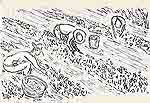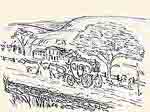
Summer 2005


|
|
 |
| Home | Index | Museums | Blog | Authors | Site Map | About |
|
The Cherry Valley Turnpikeby Walter H. Maincontributed by Richard PalmerUtica Saturday Globe, July 19, 1919One of the Notable Old Highways of Another Day, the Channel of Commerce for Western New York before the Erie Canal, a Road whose Romance of Trade is Partly Revealed in the Old Taverns that Linger by the WaysideNo, these weather-beaten old taverns along the Cherry Valley Turnpike don't yield the sort of poetry we learned in the Tales of a Wayside Inn. These are wayside inns, but they tell of no Paul Revere, they have no “Sicilian's Tale,” no “Saga of King Olaf”. So far as legend reveals it, they had no Musician who used to sit dreamily beside the roaring fire, and draw sweet fancies from his violin. When you prowl through the damp, disused, deserted ballroom of one of these old taverns, and the wide boards creak beneath your tread, they stir up a different sort of story. The shades that you may disturb in the dark corners have a different sort of poetry about them, the rude poetry and romance with which time at length softens the harsh lines that fell to the pioneer. True, they tell you little that is fanciful but they tell you most cheerfully about the wonderful whisky that used to flow, about the barrels and barrels of it, about the loads that used to require six, eight or ten horses to haul the corn juice to Albany. A garrulous shade of the past will jeer out at you from the dim corner of the tap room in one of those old taverns, and with tears in his voice will drone out to you this tale: The Days of Whiskey, Drovers and Teamsters"Why, say, mister, you orter seen them loads of whiskey! I hearn tell about a dry spell that's hit the country, when nobody da'st have whiskey, ner much of anything else. I'm glad I ain't alive to suffer." Drawing a thin, withered hand over his parched lips, the shade drones on. "Why, mister, there uster be three stills up here at Cazenovy. Think of it! Three stills. And that uster be real whisky, too! No such stuff as they've been sellin’ sence I ceased travelin' this 'ere rud" — he meant "road." "Up at Marcellus was another still. Oh, they was lots of stills out this way and they uster draw it all to Albany." "This was a great pike in them days," cackled the dry old shade from the dim corner of the tap room. "This was part of the Great Western Turnpike, straight road from Albany to Buffalo. The Cherry Valley part of it ran up through here to Syracuse. Albany to Syracuse that's it, straight's a ruler can draw the line, up through Schoharie county, through Sharon Springs - oh, it was a great old rud." If only you find a bottle of spirits to set before the dry old shade there in the corner of the tap room he would cackle on forever about the good old days of the drovers and teamsters. A tavern, you understand, springs up where there is a natural stopping place for teams — at the top of the hill, at the forks of a road at a watering place, at the natural end of a day's journey. No landlord would set up a caravansary at his own sweet will. He chooses some natural stopping place. The Old Stage Tavern at the top of the hill near Morrisville, owes its position to the fact that it was the natural place to stop and rest the team, and to "bait" the horses after a long pull up the hill from Nelson. Always teams were loaded going toward Albany. Trade From Transplanted YankeesThis string of taverns which you may see this day along the Cherry Valley Turnpike, these weather-beaten old frame structures long since turned into farmhouses, those were the natural development from the overland trade which grew from the pioneering of the post-Revolutionary period. All western New York poured its traffic over this road. It was after we had made peace with Britain, after the peace was signed in 1783 that the great migration began out of Connecticut. Up through Albany came the great tide of migration. They followed the westward way. The hand that beckoned on the restless Yankees was always the prospect of bettering their condition. Already the Connecticut country was too thickly populated. The venturesome young fellows loaded their brides, their pots and kettles, their heritage of mahogany furniture and grandfathers' clocks into their ox-carts? or into sleighs and set out, whistling a merry tune, with their axes over their shoulder. What the Dutch thought of those restless Yankees you may read in Washington Irving's Knickerbocker History of New York. He describes them as a long, lank, lean, hungry lot, crowded if any other family lived nearer than three miles, perpetually surrounded by a large squad of children, always clearing a patch in the woods, putting up a log cabin, dwelling there a spell, and always moving on into a new wilderness, of such was the population composed which entered the Promised Land of central New York at the dawning of the 19th century. You may see their marks in the names of the towns, like Hartford, Canaan and the rest. You see the reflection of the old classical learning of the east and such names as Syracuse, Scipio, Marcellus, Virgil, Cato, Pompey. This was the sturdy population which took up the new land whose great market was Albany, where the sloops from New York drew up and were laden. This was the population that produced great harvests of grain, great droves of cattle, great hogsheads of whisky, hundreds and thousands of turkeys and hogs and it was the going of this produce to tidewater that made the Cherry Valley Turnpike. Out of this traffic sprang the taverns that stand today over the memories of the past, while the present whirls by on rubber tires, unmindful of the commerce which used to toil slowly in a steady stream over this great highway. Three ancient hostelries within a few miles on the Cherry Valley Turnpike are the old Stage Tavern, Tog Hill Tavern, and the Nelson Tavern. Tog Hill Tavern is a little way west from Morrisville. It was owned in its heyday by Granley Case, and great were the doings in its famous ballroom. The elite for miles around used to find their social pleasures there. It is said really to have been the abode of fashion in its day. Granley Case had two sons, John and Dwight, who sold the property in 1862 to Samuel L. Jones, who with his heirs has used it for a farmhouse. Three Coaches a DayThe old Stage Tavern at the top of the hill near Morrisville was one of the best known and most patronized in the days of the turnpike traffic. When you consider that in those days this was the great direct route east and west, and that three stagecoaches each way rolled over this turnpike each day, you may know something of what the trade must have been about at this great square frame building. While the four horses of each stage were being fed, or while they were being changed for other teams, the wayfarers would unlumber themselves from the ponderous leather-springed stages and regale themselves with mine host's dinner. Rather more pretentious than a tavern was the Exchange Hotel at Morrisville. The village was for well nigh a century the county seat of Madison County. The Court House is still standing in which the forensic leaders of the day used to try their oratorical powers on rustic juries. The jail is there yet where prisoners used to repine. They can still point out to you the iron weight which in its day jerked into eternity on the gallows many a criminal. They can point out to you a swamp not far away that escaped prisoners hid themselves. Abode of the Legal LightsBut as to the Exchange Hotel his was a palatial caravansary in its day. Here during court week the judicial and legal lights of the county, and sometimes from other sections, used to gather. Before the days of telephones litigants had to assemble in the open days of court and tarry until their case was called. Principals, attorneys and witnesses, all had to come to court, and wait and wait for days. While they waited they stayed at the Exchange Hotel. Within a year this structure has been razed but its picture has been preserved. It was a capacious, rambling old hotel, capped with a square cupola. On the walls of the cupola you might until a year have read names of legal lights of past generations. Most of these names are forgotten now, but in their day stood for all that was legally great in the legal profession. Local legend has it that nights and Sundays the gentlemen of the law were wont to assemble in the cupola to play poker. With the trap door shut, who could prove that they were not up there to view the scenery? Road Unfrequented for YearsUntil the days of good roads and automobiles, for three-quarters of a century, the Cherry Valley Turnpike wound its way across the beautiful country in mid-New York. For not much more than a quarter century did its hey-day last as a channel of traffic. Then came the Erie canal, which from 1825 until the railroads pushed their way through, carried the produce of the great fertile hinterland to tidewater. From 1825 traffic began to dwindle over the pike, but it was a long time before it utterly ceased. The droves of turkeys, cattle and hogs, the great loads of produce and whisky kept moving over this well beaten track for years and years. Now comes the automobile and the highway comes into its own. Where once the commerce of a new century flowed to tidewater now go touring the grandchildren of those who made the old Cherry Valley Turnpike famous. Now comes the day when men name roads after great Americans. Some would name the great western turnpike the Roosevelt Highway. Leading westward, ever westward toward the setting sun, toward the land of promise, where Roosevelt never turned for his inspiration, stretches the old road. Those who travel it may look on the landmarks of the early days, when the country was new, when the vigor of the early settlers made New York the leading State in the Union, the landmarks of the old commerce, the landmarks by the side of the road, the taverns of the Cherry Valley Turnpike.
|